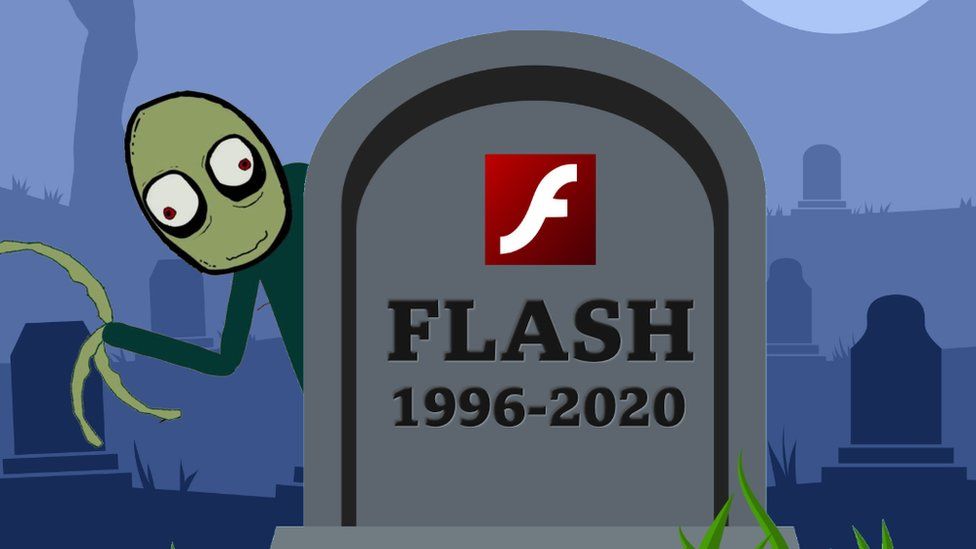
In case you didn’t know:
Adobe Flash Player, the browser plug-in that brought rich animations and interactivity to the early web, has officially reached the end of its life.
Released in 1996, Flash was once one of the most popular ways for people to stream videos and play games online. But it was plagued with security problems and failed to transition to the smartphone era. Adobe will no longer offer security updates for Flash and has urged people to uninstall it. It will also stop videos and animations running in its Flash Player from 12 January.
Why was Flash popular?
When Flash was first released, a majority of internet users connected via dial-up connections that were very slow by today’s standards.
But Flash let web designers and animators deliver exciting content that could be downloaded relatively quickly.
“You could make a full three-minute animation with multiple characters, backgrounds, sounds, and music less than 2 megabytes (MB) and viewable from within the browser,” explained animator David Firth.
The Fall
The earliest signal of Flash’s fall came in 2007 when Apple decided not to support it in the newly introduced iPhone. At the time, the fifth version of HTML was about to emerge and promised to replace some of the functionality Flash provided. With the nascent mobile web in mind, developers across the world began moving away from Flash and toward HTML5.
In 2010, Steve Jobs posted a note to the Apple website to clarify his thoughts on Flash, and further cement HTML5 as the new standard. The problem with Flash, he wrote, was that it was insecure and resource-intensive, and its plugin was overly proprietary. Jobs made the case for HTML5 and JavaScript, pointing out that they were based on open standards that web browsers could build on.
Over the next several years, HTML5 and related technologies continued to overtake the web. At the beginning of 2015, YouTube announced that its HTML5 video player was now the default. Just a few months later, it was revealed that hackers had been using an exploit in the Flash Player to inject surveillance software onto users’ computers. Facebook’s chief security officer called on Adobe to set an end-of-life date for the plugin.
Adobe discontinued Edge Animate at the end of 2015, then renamed the Flash Professional app to Animate CC. Upon announcing the rebranding, Adobe said Animate CC would be its “premier web animation tool for developing HTML5 content while continuing to support the creation of Flash content.” The company didn’t set an end-of-life date for the Flash Player plugin—it still hasn’t—but said in its announcement that developers should abandon the platform.
Facebook, became Flash’s last bastion. Some approx. 650 million users were still playing Flash-based games on the social network’s website, but Facebook had for years been looking for a way to make its games work on its mobile apps. It had attempted to launch an HTML5- and JavaScript-based games platform in 2011, but quickly scrapped the project.
What are the factors that led to the demise of Flash player?
As I mentioned above, primarily Apple, in a sense, gave Flash the kiss of death, when it took the Flash Player out of the iPhone in 2010. The factors of phasing out the Flash player are as follows:-
- Relatively old plug-in: Being a relatively old plug-in, it had flaws in code which made it increasingly vulnerable to online threats like hackers and viruses.
- It never saw the mobile revolution coming: Designed especially for desktop computers it was barely optimized for displaying contents in mobile devices, which reduced performance, reliability, and increased battery drain issues and security threats for mobile devices.
- Closed source program: For flash player is 100% proprietary, Adobe holds the sole right for further enhancements, availability, accessibility, and pricing. In such a situation, users were just paying only to use it and not to buy it.
- Withdrawal of support from major Tech Giants: Apple’s CEO, Steve Jobs put an end to the relationship with Adobe, highlighting its concerns about its reliability, security, and performance. Technology partners like Mozilla, Facebook, Microsoft, Google also followed suit and initiated their migration towards open web technologies post Adobe’s 2020 proclamation.
With the growing popularity of newer programs such as HTML5, WebGL, Web assembly popular web browsers like Google Chrome, Safari, Mozilla Firefox, Microsoft Edge, and Internet Explorer are already halfway through their roadmap of putting the last nails on the Flash player coffin by disabling its support by default and many web sites and web pages are still being updated to modern standards that contained flash content. Still phasing out of Flash player will have some noticeable impact worldwide web community.
Many of the features animators used are still available in Adobe Animate.
In its final update, Adobe said: “We want to take a moment to thank all of our customers and developers who have used and created amazing Flash Player content over the last two decades.
“We are proud that Flash had a crucial role in evolving web content across animation, interactivity, audio, and video.”
How can you remove Flash from your computer?
Adobe has provided instructions for removing Flash on Windows and Mac computers on its website.
It has warned: “Uninstalling Flash Player will help to secure your system since Adobe does not intend to issue Flash Player updates or security patches after the end-of-life date.”








